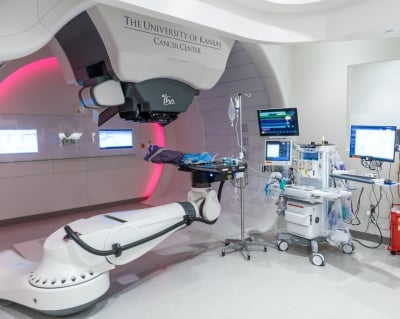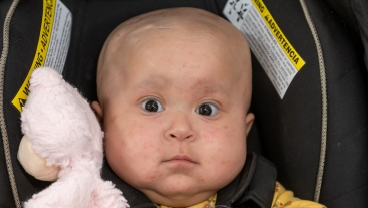Proton Therapy Reduces the Risk of Long-term Radiation Effects

Powerful treatments come with significant risks. The newest form of oncological radiation, proton therapy, delivers precisely focused radiation and decreases the likelihood of adverse effects.
“When I describe it to families, I talk about how traditional radiation comes out of the machine, hits the patient’s body, and goes straight through the other side,” said Kevin Ginn, MD, neuro-oncologist and Director of the Pediatric Brain Tumor Program at Children’s Mercy Kansas City. “The dose at entry is highest, and the further away from the machine, the lower the dose. But with proton radiation, the energy or dose enters the body at a lower level, spikes where you want it — and then stops.”
Children’s Mercy began offering proton therapy in May 2022 through their radiation partnership with The University of Kansas Cancer Center.
“As pediatric radiation oncologists, our goal is to try to maximize the chance of controlling the tumor while minimizing potential acute and late effects,” said Ronny Rotondo, MDCM, FRCPC, Director of the Pediatric Radiotherapy Program and Medical Director of Proton Therapy at The University of Kansas Health System.
“Kids’ tissues are rapidly growing and developing, so they’re particularly sensitive to the long-term effects of radiation,” said Dr. Rotondo.
During radiation therapy, patients might experience fatigue, skin damage and other impacts to the area being treated. Late effects can include neurocognitive impairments, radiation necrosis (which can cause symptoms from weakness to seizures), hearing loss, vision problems, hormone imbalances, higher stroke risks, secondary tumors and more.
Oncologists walk a tightrope, weighing the risks of treatment against the threat of the disease itself. Fortunately, scientific advancements have drastically improved childhood cancer survival rates; that means doctors take long-term risks very seriously.
“That’s where all the excitement comes from with proton therapy,” said Dr. Rotondo. “In general, you deliver a lower total-body dose compared to X-ray: about one-half to two-thirds lower overall. Most studies suggest that risk could be decreased by as much as 50%.”
In addition to treating cancer patients, Dr. Rotondo is currently conducting proton therapy research, including outcome studies and how to minimize toxicity. All Children’s Mercy proton therapy patients are included in the Proton Collaborative Group’s data registry trial, so researchers can track the long-term effects of the treatment.
Both Dr. Ginn and Dr. Rotondo stressed the importance of having proton therapy locally available. Before, if proton therapy was the best option, families had to travel hundreds of miles to one of the 38 other proton centers in the country. Not every family had the ability or resources to put their lives on hold for the five- to six-week treatment period.
“It weighed very heavily on me when I knew we couldn’t offer the best treatment in Kansas City,” said Dr. Rotondo. He is relieved to be able to offer proton therapy for patients here, at home.
“It is crucial for the community,” said Dr. Rotondo. “Through our partnership, we can collectively offer the best treatments possible for our pediatric cancer patients in our city and in the region.”
Collaborative Care Against Cancer: Camaya's Story
Camaya, one of three identical triplets, was a snuggly, happy baby until around 7 months old, when her parents noticed she was unusually listless and fussy. A rapid series of tests determined Camaya had an aggressive type of brain cancer called an atypical teratoid rhabdoid tumor.
Her Children's Mercy team, led by neuro-oncologist Kevin Ginn, MD, had to get creative with the type and sequence of Camaya's treatments in order to attack the tumor without additional damage to her brain. Read more on Camaya's journey through chemotherapy, surgery and proton therapy.

- Cancer Center
- Cancer in Adolescents and Young Adults
- Brain Tumor Treatment
- Experimental Therapeutics
- Genomic Medicine in Cancer Treatment
- Histiocytosis Program
- Leukemia and Lymphoma Program
- Li Fraumeni Syndrome
- Liver Cancer Treatment
- Proton Therapy
- Soft Tissue and Bone Sarcomas
- Spanish-Speaking Cancer Clinic
- Surveillance for Predisposition to Tumors (SPoT) Clinic
- Survive & Thrive
- Cancer Center Family Care Team
- Hematology, Oncology, and Blood and Marrow Transplant
- Meet the Team
